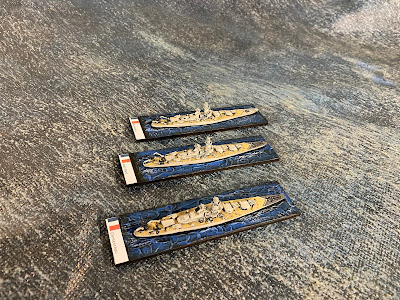The last of the six fleets and the completion of my WWII naval project, this contingent was the quickest to paint. The main reason for this is that the French fleet was for the large part taken out of action early in the war, before the more intricate camouflage schemes were applied.
The French navy included some state of the art ships which were some of the fastest at the time, including the recently built Richelieu class in the Richelieu, Jean Bart and Clemenceau. The Richelieu was initially twice attacked by the British but was eventually repaired in the USA before serving with the British Home Fleet and then being transferred for action in the Pacific, while the Jean Bart fought a duel against the USS Massachusetts during operation Torch before surrendering to the Allies:
The Dunkerque and Strasbourg were similar to the Richelieu class in that their main armament was all placed forward. This was a distinct disadvantage when attacked by the British at Mers-el-Kebir as part of the controversial Operation Catapult, as they had been docked in the harbour with their sterns facing the open water which meant they were initially unable to return fire:
I also included three ex-WWI battleships in the Bretagne, Provence and Lorraine, the difference in construction over the preceding twenty years or so being quite noticeable:
Three Suffren class heavy cruisers include the Foch, Colbert and Dupleix, seen here alongside the one-of-a-kind Algerie:
With the Duquesne and Tourville completing the small contingent of heavy cruisers:
Six light cruisers include the Duguay Trouin, Primaguet and Lammotte-Picquet:
With the La Galissonniere, Montcalm and Marseillaise completing the half dozen:
Some of the French destroyers remind me of the larger Japanese destroyers in that they are almost the size of small light cruisers but maintain the advantage of being fast, such as the 36 knots achievable by the Vauqelin class, with the Vauqelin seen here alongside her sister ships Kersaint, Cassard and Tartu:
The Fantasque class was similarly large and fast, and I completed four with the Fantasque herself, the Audacieux, Terrible and Malin:
Three Le Hardi class destroyers with the Le Hardi, Mameluk and Casque complete the contingent of French destroyers:
The last ship in the fleet is the French aircraft carrier Bearn which, even though it actually launched aircraft and completed pilot training in the early part of the war, spent most of WWII out of action in the French West Indies:
Here are all thirty-two of the French fleet in their storage box:
The Nimitz ruleset we are currently using did not originally contain game cards for the French navy and I was readying myself to spend a bit of time creating in them, but a visit to Sam Mustafa's website shows they have now been released in the last week or so.
I did a quick count across all six fleets which shows I have managed to complete a grand total of three hundred and nineteen vessels, all but twenty-five of them over the past four months. I also purchased a batch of GHQ 1/2400 scale planes which I may also get around to completing at some stage, but since most rulesets use tokens or counters to represent the aerial component of WWII naval gaming these are not a high priority and will really only be used as table dressing.
Next up, a return to my ECW project with a few Parliamentarian foot regiments prepared and ready to be painted.
































